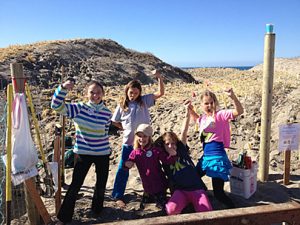Elkhorn Slough Foundation and State Parks Begin Third Season of Project

More than 300 volunteers from local schools, businesses, organizations, and the community have participated in the restoration projects since Fall 2013, planting more than 20,000 seedlings to restore coastal dune habitat and limit wind erosion.
“The community really comes through to get these plants in the ground, rain or shine. It’s inspiring to see friends and neighbors, young and old, having fun and tending to the long-term health of their local protected lands,” says ESF Outreach Coordinator Katie Pofahl.
“We’re pleased to continue our collaboration with State Parks to engage the community in restoring native habitat at Moss Landing State Beach, where the Elkhorn Slough meets the Monterey Bay,” says ESF Executive Director Mark Silberstein.
In 2011, Moss Landing State Beach was slated for closure due to severe budget shortfalls within the California State Parks system. Elkhorn Slough Foundation and California State Parks are collaborating to reinvigorate the park and protect the adjacent slough, while enabling California State Parks to cut maintenance costs and keep the park open.
•••
The Elkhorn Slough Foundation (ESF) is a community-supported non-profit land trust whose mission is to conserve and restore the Elkhorn Slough and its watershed. ESF protects 4,000 acres of rare habitat including oak woodlands, maritime chaparral, and wetlands. Since 1982, ESF has been the non-profit partner of the Elkhorn Slough National Estuarine Research Reserve (ESNERR), one of 28 research reserves funded through NOAA.
The California Department of Fish and Wildlife (CDFW) manages the 1,700-acre Reserve, providing 5 miles of public trails, education, research, and volunteer programs. For more information on Elkhorn Slough Foundation and the Reserve visit www.elkhornslough.org.
Elkhorn Slough, located in the central Monterey Bay area encompasses a wide variety of habitats — from oak woodlands, maritime chaparral and coastal prairie the largest tract of tidal salt marsh in California outside of San Francisco Bay — that support an incredible diversity of life. Elkhorn Slough hosts 550 species of marine invertebrates, and 100 species of fish, as well as resident sea lions, harbor seals and the highest concentration of endangered Southern sea otters on the west coast. As part of the Pacific flyway, Elkhorn Slough bird numbers can soar during migration seasons, nearly doubling the resident bird counts. The slough is designated a Globally Important Bird area, with more than 340 bird species identified in and around the slough.
Responsible for almost one-third of California’s scenic coastline, the California State Park system includes beaches, trails, wildlife areas, open spaces, off-highway vehicle areas, and historic sites. It consists of approximately 1.59 million acres, including more than 339 miles of coastline, 974 miles of lake, reservoir and river frontage, approximately 15,000 campsites and alternative camping facilities, and 4,456 miles of non-motorized trails.